Mérida, Yucatán 作者: 来源: 发布时间:2021-05-27
1.Population and Area
Pop.: 892,363
Area: 858.41 km2
Elev.: 10 masl
Mérida location in Mexico within the state of Yucatán
https://goo.gl/maps/bLMxKSGpiwBvPWeu9
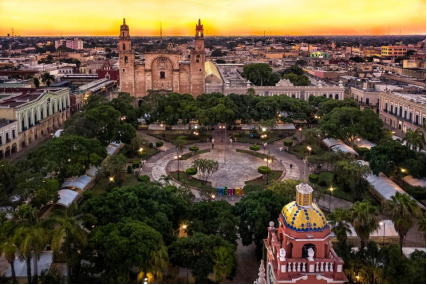
2. Natural geography
Mérida is located in the northwest part of the state of Yucatán, which occupies the northern portion of the Yucatán Peninsula. To the east is the state of Quintana Roo, to the west is the state of Campeche, to the north is the Gulf of Mexico, and far to the south is the state of Chiapas. The city is also located in the Chicxulub Crater. It has a very flat topography and is only 30 feet (9 m) above sea level. The land outside of Mérida is covered with smaller scrub trees and former henequen fields. Almost no surface water exists, but several cenotes (underground springs and rivers) are found across the state.
The flora is formed by tropical deciduous vegetation and thorny forest, locally considered as low forest and corresponding to or associated with very shallow and stony soils. This flora has little commercial value. Non-timber trees reach a maximum height of 6 meters.
The most common species of animals that inhabit the municipality are mammals: rabbit, deer, gopher, opossum, skunk; reptiles: variety of iguanas and snakes; birds: swallows, pigeons, tzutzuy, and those existing in the natural reserve of Dzibilchaltún.
http://www.elclima.com.mx/merida_yucatan.htm#:~:text=Flora%20y%20Fauna%20de%20M%C3%A9rida&text=Las%20especies%20m%C3%A1s%20comunes%20de,la%20reserva%20natural%20de%20Dzibilchalt%C3%BAn.
Weather
Köppen Classification: Tropical Savanna Climate
Tropical savanna climates have monthly mean temperature above 18°C (64°F) in every month of the year and typically a pronounced dry season, with the driest month having precipitation less than 60mm (2.36 in) of precipitation. In essence, a tropical savanna climate tends to either see less rainfall than a tropical monsoon climate or have more pronounced dry seasons than a tropical monsoon climate. Tropical savanna climates are most commonly found in Africa, Asia and South America. The climate is also prevalent in sections of Central America, northern Australia and North America, specifically in sections of Mexico and the state of Florida in the United States.
The Köppen Climate Classification subtype for this climate is "Aw". (Tropical Savanna Climate).
The average temperature for the year in Merida is 80.0°F (26.7°C). The warmest month, on average, is May with an average temperature of 85.0°F (29.4°C). The coolest month on average is January, with an average temperature of 74.0°F (23.3°C).
The highest recorded temperature in Merida is 108.0°F (42.2°C), which was recorded in April. The lowest recorded temperature in Merida is 34.0°F (1.1°C), which was recorded in February.
The average amount of precipitation for the year in Merida is 36.1" (916.9 mm). The month with the most precipitation on average is September with 6.3" (160 mm) of precipitation. The month with the least precipitation on average is February with an average of 0.9" (22.9 mm).
https://www.weatherbase.com/weather/weather-summary.php3?s=44667&cityname=Merida%2C+Yucatan%2C+Mexico&units=
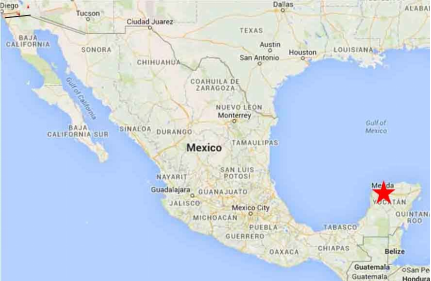
Getting there and around
By air
Merida's Manual Conscencio Rejon International Airport (IATA: MID), is located 7.5 km south of the city along Hwy 261 and offers services to all types of flights, private and commercial. There are daily flights between Mérida and México City, Houston, Miami, Belize City, Havana and a few other cities in México. The following airlines serve Mérida:
Aeromexico, Aeromexico Connect: Mexico City, La Havana, Miami, Monterrey & Veracruz; Aeromar: Tuxtla Gutierrez, Villahermosa & Cancun; American: Miami; Delta: Atlanta; Interjet: Mexico City; Magni: Mexico City; Mayair: Cancun, Cozumel, Villahermosa & Veracruz; TropicAir: Belize City; United; Houston; Viva Aerobus: Guadalajara & Monterrey; Volaris: Mexico City, Guadalajara & Monterrey.
To get from the Airport to your local destination (by ground transport) you have several options:
·Take an authorized taxi cab or van, at the Airport for MN$200-250. Buy the ticket in a booth outside of the airport exit doors.
·Uber is allowed to pickup/drop off at the airport. Approx fare to City centre. MN$65-100 (8Oct18)
·Hail a taxi for half the cost on the main road (Calle 23). To get there you must walk a fair distance out past the main parking lot in front of the building, and along the access road.
·Take an ADO (Autobuses De Oriente) bus, which runs regularly from the airport to the main CAME bus station (Calle 70 entre 69 y 71, #555) or up to the Hotel Fiesta Americana (Calle 60 por Avenida Colón). See "By bus" below for details. The airport bus stop is next to the crosswalk on the island along the second access road in front of the arrivals (llegadas) doors on the north end of the terminal.
·Take a local city bus on Calle 23 (see above). Buses heading north (to the right) towards Hwy 261 bear the legend "79 Aviacion” or "El Centro” displayed on the windscreen/windshield. The former is more convenient while the latter is more frequent and cheaper.
The bus from downtown to the airport leaves from Calle 69 x 62.
Cancun (CUN) has more flights on regularly scheduled airlines, as well as charter airlines with tours to and from Europe, North America, Central America, South America, Cuba, Russia, and additional cities within Mexico. With the extra competition, it may be more economical to fly to Cancun and then drive or take the bus to Merida. See "By bus" below for details.
By bus
There are 3 "main" bus stations in Merida:
Grupo ADO (CAME), Calle 70 #555 (Calle 70 btwn Call 69 & 71), ☎ +52 999 924-83-91 (toll free: 0800 702-80-00). ADO (Autobuses De Oriente) [13] & OCC first class, ADO GL Deluxe & ADO Platino on longer routes to various major cities in Yucatan, Campeche, Quintana Roo, Tabasco, Chiapas & Oaxaca states and to/from Mexico City ($1,182 pesos or ~US$95.53 for 20-24hrs). ADO buses also run between the CAME and the Merida airport. edit The CAME is in a commercial area of El Centro.
Terminal de Autobuses de 2a Clase (2nd class bus station), Calle 69 #554 (Along Calle 69 between Calle 68 & 70. Next to first class CAME terminal), ☎ +52 999 920-44-44 & 924-83-91. This the 2nd class bus station right next to the ADO terminal in centro, on calle 69. The lines serving this station are second class ADO, Oriente, Mayab & ATS buses (all subsidiaries of Grupo ADO) to various cities & towns in Yucatan, Campeche & Quintano Roo states, such as to Cancun, Valladolid, Piste, Chichen Itza, Progreso, Izamal, Oxkutzcab, Uxmal, Ticul, Tulum, and Celestun.
Fiesta Americana, Calle 60 por Av. Colon (Across Calle 60 (west) from the big Hotel Fiesta Americana), ☎ +52 999 920-55-23. Alternate bus station for ADO, ADO GL, Platino, and SuperExpresso buses to/from Cancun, Playa del Carmen and the airport The Fiesta Americana terminal is in a better area of the city, a short taxi ride to El Centro, but with a more limited number of bus connections.
Additional bus companies (mainly offering second class service) have their own bus stations in other parts of town:
AutoCentro, Calle 46 No 517, por 65 y 67; Merida, YUC, ☎ +52 999 923 9962. operates second class bus service between Cancun & Merida via Tixpeual, Tixkokob, Euan, Cacalchen, Izamal, Tunkas, Dzitas, Valladolid, Chemax, Xcan and/or Leona on three different routes. These buses stop anywhere along the road to pick up and drop off people on request.
Autobuses del Noreste en Yucatan, Calle 67 Nº 531 por 50, Merida Centro (Along 67 between 50 & 52 at middle of block), ☎ +52 999 924-6355. Another second bus station for Autobuses del Noreste, Lineas Unidas del Sur & Oriente to Kanasín, Acanceh, TecohM, Telchaquilllo, Tekit, Muna, Chumayel, Teabo, Tipikal, Maní, Oxcutzcab, Mayapán, Cantamayec, Yaxuná, Rio Lagarto, Izamal, Tizimin, Valladolid and other surrounding towns & villages in the area on multiple routes.
Terminal Auto Progreso, Calle 62 #524 (Along Calle 62 between Calle 65 & 67), ☎ (999) 924 89 91 & 928 39 65. Regular buses to Progreso.
The trip from Cancun to Merida is about 380 km, and takes about four hours. There is bus service from the Cancun Airport as well as from the downtown Cancun terminal (with buses between the two every half hour). The buses that depart from the airport seat about 15 and, while excellent vehicles, are not as luxurious as the big ones with driver mirrors that look like huge antennae. Each bus goes to either the main (CAME) terminal or the Fiesta Americana terminal (see above).
On longer routes like this one, ADO offers three levels of service: ADO, ADO GL, and ADO Platino. ADO Platino is the highest class of service, with tickets costing around $438 pesos. It has free instant coffee packs with hot water, single seats on one side of the bus, and TVs on the back of every seat offering an array of movies and TV shows, including some in English. ADO GL at $322 pesos is a step down without the extras, but more legroom than the regular ADO buses. Both the GL and Platino busses travel on the toll highway 180D, which is kept in excellent condition and has limited access. The regular ADO bus cost $268 pesos. It travels the parallel route 180, which has no tolls but is bumpier and goes through more than 40 villages and 70 hamelets, making the ride a bit longer. On balance, the ADO Platino seems worth the extra price.
An example of 2nd class bus service is the Oriente bus to Valladolid. This trip in January 2014 cost $97 pesos. The seats were comfortable, the air conditioning was at a comfortable setting (not set to "Arctic"), and there was no disturbing tv. However, the bus stopped to pick up and drop off passengers basically everywhere, which led to a crowded bus with people packed in the aisle, and a ride that would otherwise take 2 hours took 3.5 hours.
Get around
The streets in most of the parts of of interest to visitors are in a rough grid with numbers for street names. Even numbered streets run from north to south, with the numbers increasing as you go further west; odd numbered streets run from east to west, with the numbers increasing as you go further south. This makes it easy to tell how many blocks away from something you are (just remember to divide by two when counting blocks in the same direction). Addresses are commonly given as either intersections of two streets, or stated as on a street between two cross streets. For orientation in the old part of town, remember the Cathedral and Zocalo (main square) are at the corner of 60 and 61 ("Calle 60 x 61")
Note: virtually of Merida Centro's roads are in a one way grid pattern, with every other road N/S or E/W going the opposite direction; one way signage is small and sometimes hidden from easy view, while locals on foot are helpful and tolerant, locals in vehicles are not pleased when driver in front dithers; just like Paris, Rome or Singapore.
If staying in the older central part of town, many attractions, restaurants, etc. are within walking distance for those who don't much mind walking in the tropical climate. Buses and taxis are numerous and reasonably priced.
Organized tours are available from a variety of companies.
Walker Alert: much like the walkways of many cities and towns in Mexico, those of Mérida, especially in the city center, are fraught with hazards. The sidewalks present you with with plenty of booby-trap-like irregularities and impediments which can easily cause a fall. Toe-catching bolts, clips and small sundry projections can be overlooked quite easily, especially when you are absorbed in the sights around you. In the city center there is usually no space to serve as a buffer between street and sidewalk. Traffic is zipping by just inches away from the sidewalk, many of which are quite narrow, mere ledges in places. A tumble into the street can make for a very bad day. Adding to the hazardous conditions, the sidewalks become surprisingly slippery when wet. Besides walkways wet from rain, you might find wet sections ahead as storekeepers commonly scrub down the walk in front of their building. Slow down and step extra carefully. Think ice. Prudence calls for extra-careful scanning of the way before you as you amble down Mérida’s busy streets. It is not just the sidewalk that is at issue; unexpected head-bangers (rods, bars, poles, wires, etc.) poking out from building walls can also beset you with a measure of grief. Mindful walking is the order of the day.
https://wikitravel.org/en/M%C3%A9rida_(Yucat%C3%A1n)
3 . GDP
GDP: 258,936 M MXN
4. Industry
The Yucatan Peninsula, in particular the capital city Mérida, is in a prime location which allows for economic growth. Mérida has been a popular location for investment. This, in turn, has allowed the Yucatan economy to grow at three times the rate of the national average. Since Mérida is the capital city of Yucatan and one of the largest cities in this section of Mexico, region-based urbanization is highly influential, in comparison to city-based urbanization. As the capital city of the state of Yucatan, Mérida has its advantages, "Cities, particularly capital cities, are where the vast majority of modern productive activities are concentrated in the developing world and where the vast majority of paid employment opportunities are located." Many resources have been allocated to this region, but not everyone prospers with the influx of these resources. High rates of urban poverty can be attributed to the rapid development of these cities and resource and service allocation can be disproportionate between the rich and the poor of the area. Due to the rapid expansion of these cities, there is uneven distribution of services among members of the community. Due to the developing economy, based on urbanization of the city, high rates between the social classes are present; notable zones throughout the city are visible marking where the upper or lower class are present.
Circuito Sur project
The objective of the project is to promote the inclusive development of the city of Mérida: to communicate and articulate the southern and southeastern area of the city separated from each other by the airport and, in turn, with the rest of the city.
The key concepts that guide this work are: inclusion and equity. South Circuit is the articulating axis of urban mobility that connects the southern neighborhoods of the city. This implies that it will be possible to make the journey safely and efficiently, in much less time, breaking the inequality gap and allowing the inclusive development of Mérida.
The Southern Circuit will connect San José Tecoh Sur, Emiliano Zapata Sur and San Antonio Xluch with El Roble. That is, the connection continues from Calle 50 Sur, 60 Sur, 86 Sur and 185, through a new street to Calle 16 de El Roble Agrícola and from there to Avenida Aviación of the Industrial City, benefiting more than 60,250 people and more than 20 neighborhoods.
The design of the road takes into consideration all street users: pedestrians, cyclists, motorists and public transport concessionaires, since the design criteria of sustainable mobility are incorporated.
http://isla.merida.gob.mx/serviciosinternet/ordenamientoterritorial/paginas/proyectos.phpx
5. Touristic sites
Gran Museo del Mundo Maya
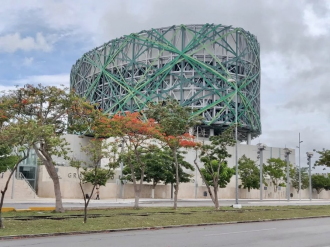
If you want to learn more about the Mayan people, culture, and history, the Mayan World Museum is most definitely the place to do it. We don’t know of anywhere else in the world with more Mayan artifacts under the same roof. There are over 1,000 different pieces here.
This expansive museum will leave visitors with a deep understanding of the Mayan civilization. The Mayan World museum takes guests on a journey that begins with natural history from the beginning of time. The exhibits slowly progress to the life of the modern Maya today.
It’s all a great primer before visiting the many ancient Mayan sites throughout the Yucatan. Most of those ruins lack information at the actual sites. So visiting the Maya Museum can be a good idea to do in Merida to gain some knowledge about the Maya before venturing out to ruin sites. Those who are fascinated with history can likely spend several hours perusing the exhibits of the Mayan World Museum.
Just be aware that visiting this museum is the only thing to do in Merida listed within this guide that is well outside Merida Centro. But don’t let that hinder you from heading out to Merida’s northern outskirts. This impressive museum is worth the trip to deeply explore the local Mayan culture and history. Plus it’s cheap and easy to take an Uber to the museum. The 20-minute ride from Centro should cost around between $80-$100 pesos.
Teatro Jose Peon Contreras
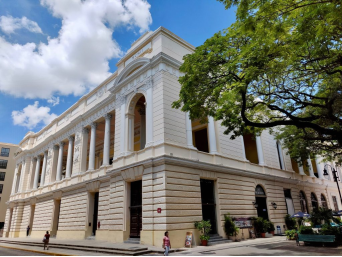
Even if you’re not actually going to have a night out at the theatre, it’s worth popping into the Teatro Jose Peon Contreras during the day. It’s a worthwhile thing to do in Merida to simply have a look around the elegant century-old theatre. While popping in, don’t hesitate to visit the small, free, air-conditioned art museum. This little museum can simultaneously be used as a great excuse to cool-off while viewing the funky exhibits.
After taking in the art, walk by the impressive marble staircase towards the box-office to see if there may be any events during your visit. Typically there are symphonies on most (not all) Fridays at 9:00 pm and Sundays at Noon. Getting tickets for a theatre night could prove to be a classy way to spend a Friday evening, or to escape the mid-day heat on a Sunday.
The Peon Theatre itself is stunning, which provides an air of elegance, and is free to visit. Yet spending a few pesos on a night at the theatre in Merida remains a surprisingly budget-friendly pursuit.
Paseo de Montejo
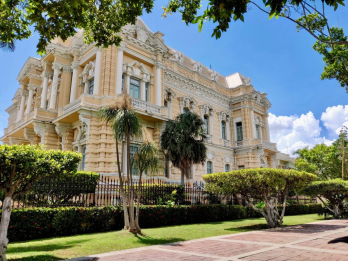
You can’t come to Merida without seeing the grand Paseo de Montejo. This wide avenue built in Merida’s heyday conjectures images of Paris’s Champs-Élysées. Historic mansions line the grand avenue, as do many quaint cafes.
There's even an inviting Starbucks along the Paseo that blends right into the white cityscape. But with many great local cafes, we suggest stopping into one of those instead. To break up your stroll this broad boulevard, go have a coffee at Sukra or Pistache. You'll pass both along the way on the east side of the road. Or go to Posheria, where they'll add a shot of pox (local Mayan liquor) into your iced latte, upon request.
You can also find two notable museums while strolling the west side of the Paseo. The Casa Museo Montes Molina provides 45-minute guided tours of the period furnishings around this mansion that served generations of Montejos, descendants of Merida's founder.
Info: English tours are Monday-Friday, 9 am, 10 am, 11 am, & 3 pm; Saturdays at 9 am & 11 am.
The Palacio Canton showcases Mayan archaeology across two levels of a big Neoclassical mansion, pictured below. If you don't have a chance to make it to the big Mayan World museum (suggested earlier in this article), then this is a closer albeit smaller alternative to consider visiting to view Mayan artifacts.
Info: It's $60 pesos to get in and opens every day except Mondays, 8:00-5:00.
https://www.roamingaroundtheworld.com/top-5-things-to-do-in-merida-mexico
MACAY

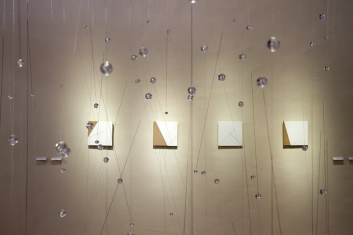
Next to the cathedral and inside one of the city’s most historic buildings, the Museo de Arte Contemporaneo Ateneo de Yucatán (MACAY) offers a great place to escape the sweltering heat of the sun and take in some thought-provoking modern art. During our visit, we were almost as impressed by the fabulous air-conditioning as by the bizarre pieces hanging on the walls.
The museum is totally free to visit, so even if contemporary art isn’t your thing, there’s no reason not to take a quick tour. This building was constructed in 1573 as an ateneo, or private cultural institution, on the orders of the Bishop Diego de Landa. Perhaps he was still feeling a tinge of guilt for having destroyed every Maya codex, book and idol he could get his hands on during 1562’s notorious auto-da-fé in Maní. Regardless, the ateneo is a striking building, and has found a perfect modern purpose as home to the MACAY.
The exhibition begins on the upper floor in a series of rooms organized around a courtyard. Most of the rooms are dedicated to temporary collections, focusing mostly on contemporary Mexican artists, though there are a couple permanent exhibitions. One features the work of Mérida’s own Fernando Castro Pacheco, one of Mexico’s greatest muralists. We had already been impressed by his work in the nearby Palacio del Gobierno, and were happy to see more.
A tour through the museum can take about an hour, depending on your tolerance for contemporary art. For me, it was a mixed bag; some of the exhibitions were truly fantastic, while others inspired “what a load of rubbish”-type sentiments. But still, I was disappointed when, after walking through the sculpture garden, our tour had come to its conclusion. The MACAY is quiet, cool and interesting, and spending time there is a pleasure.
https://yucatan.for91days.com/macay-meridas-contemporary-art-museum
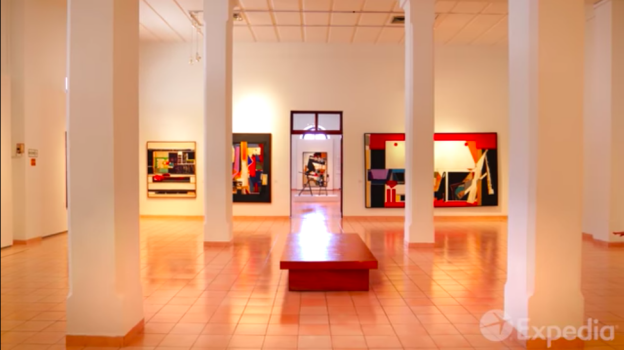
Merida Vacation Travel Guide | Expedia
https://youtu.be/7c8xJjcsGwc
6. History and Culture
Mérida was founded in what was the city of Ichcaanzihó, also called Thó. This indigenous seat at the beginning of its conquest was occupied by about a thousand inhabitants and about 200 houses that surrounded three main squares.
Both settlements, the pre-Hispanic and the colonial, had in common an orthogonal layout. The first one that corresponded to the post-classic Mayan period, was composed of large squares surrounded by platforms and pyramidal bases of temples and palaces. Four avenues departed from the ceremonial center of Thó towards the four cardinal points that communicated with the chiefdoms and nearby towns.
In March 1517, the expedition led by Don Francisco Hernández de Córdova landed at Cabo Catoche. What the discovery of what we know today as the Yucatan Peninsula meant. On December 18, 1526, just nine years after the discovery of the Yucatecan territory, the capitulation of the conquest of Yucatán was signed in Granada, Spain, and then Francisco de Montejo was named Adelantado de Yucatán.
During the third expedition to conquer these lands, on January 6, 1547, Francisco de Montejo el Mozo founded the city of Mérida, with the same name as the Andalusian Spanish city.
From this square the four main streets of the city would come out, which would be structured in 20 blocks for the civil and ecclesiastical authorities; the subsequent ones were divided into four lots for the conquerors and settlers.
In its origins, the Yucatecan territory depended on and was regulated through the Audiencia de los Confines, located in the territory of what is currently Guatemala. However, on January 9, 1560, the Royal Decree was decreed through which Yucatán became totally dependent on the Audiencia of Mexico.
Carved Maya stones from ancient T'ho were used to build the Spanish colonial buildings which are numerous in downtown Mérida; these stones are visible, for instance, in the walls of the main cathedral. Much of Mérida's architecture from the colonial period through the 18th century and 19th century is still standing in the centro historico of the city. From colonial times through the mid-19th century, Mérida was a walled city intended to protect the Peninsular and Criollo residents from periodic revolts by the indigenous Maya. Several of the old Spanish city gates survive, but modern Mérida has expanded well beyond the old city walls.
On July 30, 1847, one of the conflicts with the greatest resonance in the history of this entity began, the "War of Castes" which consisted of the rebellion of the Mayan indigenous people against the families of mestizos and "whites".
One of the greatest influences in Yucatecan history is that of the henequen plant, also called sisal (after the Yucatecan city of Sisal, where the shipments from the continent came from). This plant became the "green gold" for the wealth it produced in the landowners of this area.
Late in the 19th century and the early 20th Century, the area surrounding Mérida prospered from the production of henequén. For a brief period, around the turn of the 20th century, Mérida was said to house more millionaires than any other city in the world. The result of this concentration of wealth can still be seen today. Many large and elaborate homes still line the main avenue called Paseo de Montejo, though few are occupied today by individual families. Many of these homes have been restored and now serve as office buildings for banks and insurance companies. Korean immigration to Mexico began in 1905 when more than a thousand people arrived in Yucatán from the city of Incheon. These first Korean migrants settled around Mérida as workers in henequen plantations.
Completed in 1911 by Camilo and Ernesto Cámara Zavala, “Las Casas Gemelas” (The Twin Houses), are two side by side French and Spanish style mansions that remain from the early 20th Century. They are two of only a few houses that are still used as residences on Paseo Montejo from that era. They are owned by the Barbachano and Molina Méndez families. During the Porfiriato, the Barbachano house held cultural events that hosted artists, poets, and writers. In the mid-1900s, the Barbachanos hosted such luminaries as Princecess Grace and Prince Ranieri of Monaco, as well as first lady of the U.S., Jacqueline Kennedy.
Mérida has one of the largest centro histórico districts in the Americas (surpassed only by Mexico City and Havana, Cuba). Colonial homes line the city streets to this day, in various states of disrepair and renovation; the historical center of Mérida is currently undergoing a minor renaissance as more and more people are moving into the old buildings and reviving their former glory.
In August 1993, Pope John Paul II visited the city on his third trip to Mexico. The city has been host to two bilateral United States – Mexico conferences, the first in 1999 (Bill Clinton – Ernesto Zedillo) and the second in 2007 (George W. Bush – Felipe Calderón).
In June 2007, Mérida moved its city museum to the renovated Post Office building next to the downtown market. The Museum of the City of Mérida houses important artifacts from the city's history, as well as an art gallery. Mérida hosted the VI Summit of Association of Caribbean States, in April 2014.
Mérida is the cultural and financial capital of the Yucatán Peninsula, as well as the capital city of the state of Yucatán. In recent years, important science competitions and World events have been held in Mérida – FITA Archery World Cup Finals, the International Cosmic Ray Conference, a Physics Olympiad, etc.
7.Contact Information
City Mayor: Renán Barrera Concha
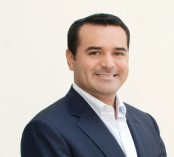
Contact number: +52 (999) 924 4000, ext. 80300
Govt. Office Address: Calle 62 s/n, Palacio Municipal, Colonia Centro C.P. 97000, Mérida, Yucatán, México
Twitter: https://twitter.com/ayuntamerida
FB: https://www.facebook.com/AyuntaMeridaOficial
Website: http://www.merida.gob.mx
E-mail: renan.barrera@merida.gob.mx
